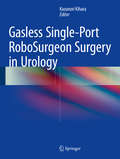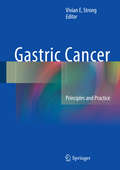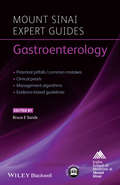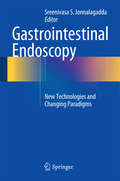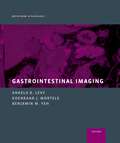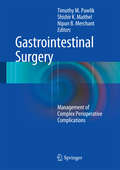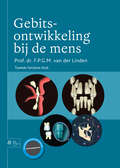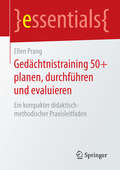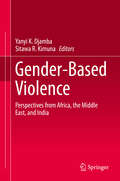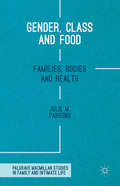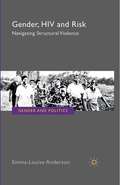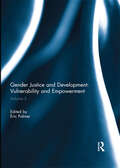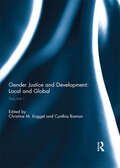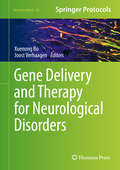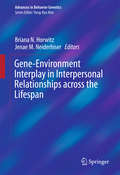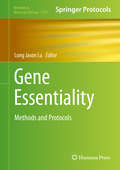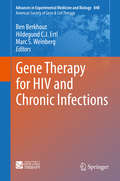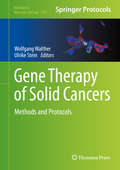- Table View
- List View
Ganzheitliche Pflege von alten Menschen
by Monika Specht-TomannIn vielen Pflegeeinrichtungen steht im Vordergrund die medizinische Versorgung. Wer sich bewusst macht, dass dies der letzte Lebenswohnraum der meisten alten Menschen ist, verändert seinen pflegerischen Schwerpunkt. Ganzheitliche Pflege bezieht die körperliche, seelische und soziale Ebene der Person mit ein. Nehmen Sie die individuelle Bedürfnisse Ihrer Bewohner wahr und begleiten Sie sie einfühlsam zum Lebensende.Der InhaltBedürfnisse und Veränderungen in der besonderen Lebenszeit AlterBetreuung Schritt für Schritt: von der Aufnahme ins Heim bis zum AbschiedDarstellung der Schmerzformen und der speziellen PflegeinterventionenBegleitung Demenzkranker unter besonderer Berücksichtigung der BiografiearbeitSterbebegleitung und Abschiedskultur im HeimFür Pflegedienst- und Pflegeheimleitungen, Pflegende, Begleiter und Betreuer alter Menschen. Den letzten Lebensabschnitt positiv und würdevoll gestalten!
Gasless Single-Port RoboSurgeon Surgery in Urology
by Kazunori KiharaThis book focuses on a novel series of minimally invasive surgeries performed without gas insufflation and through a single port using the RoboSurgeon system. The concept of RoboSurgeon surgery involves a degree of “robotization” of the operator and participants. The operator, wearing a head-mounted display, uses robot-like handheld instruments. The endoscope is controlled by the movement of the operator’s head using a gyro-sensor system. All participants wearing head-mounted displays can see the same images as the operator does. Although this surgery is mainly intended for urological cancers, it may also be applicable for various operations concerning other urological diseases, as well as for the treatment of diseases in different medical fields. The system has the potential to become the new standard in robotic surgery. This solution may be a boon to many patients around the world, especially in the aging societies many countries are now facing.
Gastric Cancer: Principles and Practice
by Vivian E. StrongThis volume provides the most comprehensive and complete resource available on all aspects of gastric cancer and it’s management. The book covers topics such as oncologic approaches to staging, treating, and following patients, filling a critical need for resource materials on these areas. As multidisciplinary care is an integral part of gastric cancer treatment, this text is unique in including a renowned group of expert authors from a variety of disciplines, including pathology, gastroenterology, medical oncology, surgery and clinical genetics. In addition, authors from an international pool of gastric cancer experts have covered the breadth of practice and understanding globally.Edited and organized by an expert from one of the most highly respected cancer institutions in the country, Gastric Cancer: Principles and Practice is an expert review of this field, serving as a valuable reference for physicians in training and in practice, as well as for researchers who are interested in the scope of issues and advances in this important malignancy.
Gastroenterology (Mount Sinai Expert Guides)
by Bruce E. SandsMount Sinai Expert Guides: Gastroenterology will provide physicians with an extremely clinical and accessible handbook covering the major GI diseases and symptoms, their diagnosis and clinical management. Perfect as a point-of-care resource on the hospital wards and also as a refresher for board exam preparation, the focus throughout is on providing rapid reference, essential information on each disease to allow for quick, easy browsing and assimilation of the must-know information. All chapters follow a consistent template including the following features: - An opening bottom-line/key points section - Classification, pathogenesis and prevention of disease - Evidence-based diagnosis, including relevant algorithms, laboratory and imaging tests, and potential pitfalls when diagnosing a patient - Disease management including commonly used medications with dosages, when to perform surgery, management algorithms and how to prevent complications - How to manage special populations, ie, in pregnancy, children and the elderly - The very latest evidence-based results, major society guidelines (ASG/ACG/UEGW) and key external sources to consult In addition, the book comes with a companion website housing extra features such as case studies with related questions for self-assessment, key patient advice and ICD codes. Each guide also has its own mobile app available for purchase, allowing you rapid access to the key features wherever you may be. If you specialise in gastroenterology and require a concise, practical guide to the clinical management of GI disease, bought to you by one of world's leading hospitals, then this is the perfect book for you.This title is also available as a mobile App from MedHand Mobile Libraries. Buy it now from iTunes, Google Play or the MedHand Store.
Gastroenterology (Mount Sinai Expert Guides)
by Bruce E. SandsMount Sinai Expert Guides: Gastroenterology will provide physicians with an extremely clinical and accessible handbook covering the major GI diseases and symptoms, their diagnosis and clinical management. Perfect as a point-of-care resource on the hospital wards and also as a refresher for board exam preparation, the focus throughout is on providing rapid reference, essential information on each disease to allow for quick, easy browsing and assimilation of the must-know information. All chapters follow a consistent template including the following features: - An opening bottom-line/key points section - Classification, pathogenesis and prevention of disease - Evidence-based diagnosis, including relevant algorithms, laboratory and imaging tests, and potential pitfalls when diagnosing a patient - Disease management including commonly used medications with dosages, when to perform surgery, management algorithms and how to prevent complications - How to manage special populations, ie, in pregnancy, children and the elderly - The very latest evidence-based results, major society guidelines (ASG/ACG/UEGW) and key external sources to consult In addition, the book comes with a companion website housing extra features such as case studies with related questions for self-assessment, key patient advice and ICD codes. Each guide also has its own mobile app available for purchase, allowing you rapid access to the key features wherever you may be. If you specialise in gastroenterology and require a concise, practical guide to the clinical management of GI disease, bought to you by one of world's leading hospitals, then this is the perfect book for you.This title is also available as a mobile App from MedHand Mobile Libraries. Buy it now from iTunes, Google Play or the MedHand Store.
Gastrointestinal Endoscopy: New Technologies and Changing Paradigms
by Sreenivasa S. JonnalagaddaThis comprehensive treatise on cutting edge tools and research provides a fascinating insight into the rapidly evolving field of diagnostic and therapeutic endoscopy. Accomplished international researchers and clinicians discuss the latest endoscopic advances in diverse areas including obesity and associated metabolic syndromes, management of peripancreatic fluid collections, endoluminal suturing techniques, fistula closure, management of Barrett’s epithelium, cholangioscopy, chromoendoscopy, high resolution manometry and endoscopic ultrasonography. Gastrointestinal Endoscopy: New Technologies and Changing Paradigms is a valuable resource on the evolving role of endoscopic management of gastrointestinal diseases and is a tremendous resource for gastroenterologists, endoscopists, GI surgeons, and medical residents.
Gastrointestinal Imaging (Rotations in Radiology)
by Angela D. Levy, Koenraad J. Mortele and Benjamin M. YehGastrointestinal Imaging presents a comprehensive review of gastrointestinal pathologies commonly encountered by practicing radiologists and residents in training. Chapters are organized by organ system and include the Pharynx and Esophagus, Stomach, Small Bowel, Appendix, Colon, Anorectum, Liver, Gallbladder, Bile Ducts, Pancreas, Spleen, Peritoneum, Mesentery, and Abdominal Wall, and a chapter on multisystem disorders. Part of the Rotations in Radiology series, this book offers a guided approach to imaging diagnosis with examples of all imaging modalities complimented by the basics of interpretation and technique and the nuances necessary to arrive at the best diagnosis. Each pathology is covered with a targeted discussion that reviews the definition, clinical features, anatomy and physiology, imaging techniques, differential diagnosis, clinical issues, key points, and further reading. This organization is ideal for trainees' use during specific rotations and for exam review, or as a quick refresher for the established gastrointestinal imager.
Gastrointestinal Surgery: Management of Complex Perioperative Complications
by Timothy M. Pawlik Shishir K. Maithel Nipun B. MerchantAdvances in surgical technique and broadening indications for complex gastrointestinal procedures, surgical management of thoracic, hepato-pancreato-biliary, and colorectal diseases continues to evolve, but morbidity continues to be a persistent problem. This book provides a comprehensive, state-of-the art, definitive reference for the diagnosis and management of difficult-to-manage complications following advanced gastrointestinal surgery. All chapters are written by experts in their field and include the most up-to-date clinical information from national and world leaders in their respective discipline. The text provides a practical, clinically useful guide that reviews risk factors for these complications and offers key information on how to avoid potentially high morbidity events in the peri-operative period. It also discusses the management of these problems when they do occur. With its helpful guidelines and “tricks of the trade” to avoid potential complications, this book is essential to all medical professions treating such patients.Gastrointestinal Surgery: Management of Complex Perioperative Complications is of great value and utility for general surgeons, thoracic surgeons, upper gastrointestinal surgeons, colorectal surgeons, hepato-pancreato-biliary surgeons, surgical oncology fellows, thoracic surgery fellows and upper level residents in general surgery.
Gebitsontwikkeling bij de mens
by F.P.G.M. van der LindenVanaf 1979 was het in zeven talen verschenen boek Gebitsontwikkeling van de auteur hét internationale standaardwerk over dit onderwerp. De laatste Nederlandse editie kwam uit in 1994. Er is sindsdien geen enkel boek verschenen dat de kennis over gebitsontwikkeling op systematische en inzichtelijke wijze aanbiedt. Daar is nu verandering in gekomen. Gebitsontwikkeling bij de mens begint met de aanleg van gebitselementen. Daarna volgen de ontwikkeling van het melkgebit, de wisseling, de overgang naar het blijvend gebit en de situatie bij de oudere mens. Uitgebreid wordt ingegaan op de samenhang en wederzijdse beïnvloeding van de ontwikkeling van het gebit, de groei van het gelaat en de rol van functionele factoren daarin. Daarna komt de ontwikkeling van alle orthodontische afwijkingen aan de orde, gevolgd door het effect van voortijdig verlies van melkelementen. Het boek sluit af met numerieke en grafische informatie. De onderwerpen worden bondig en helder besproken en met duidelijk beeldmateriaal toegelicht. Zo bevat het boek meer dan 550 kleurenafbeeldingen en ruim 250 foto’s van schedels met vrijgelegde en afzonderlijk opgestelde dentities. Bovendien is er een website waarop 50 bewegende scènes in ‘virtual reality’ te zien zijn. De video’s op de website en de afbeeldingen in het boek bieden een goed driedimensionaal inzicht in de gebitsontwikkeling. Mede daardoor is het boek een bruikbaar hulpmiddel bij het geven van patiëntenvoorlichting. Dit boek is vooral bedoeld voor tandartsen, orthodontisten, pedodontisten, mondhygiënisten en tandartsassistenten. Het is een onmisbaar studieboek voor studenten tandheelkunde en mondzorg. Daarnaast is Gebitsontwikkeling van de mens van belang voor alle medici die beroepsmatig met kinderen te maken hebben, zoals huisartsen, kinderartsen, consultatiebureauartsen en jeugdartsen. Door de helder geschreven tekst en de instructieve illustraties is specifieke voorkennis niet nodig. Prof. dr. F.P.G.M. van der Linden was van 1962 tot 1995 hoogleraar en hoofd van de afdeling Orthodontie aan de Radboud Universiteit te Nijmegen. In 1969–1970 was hij een jaar als ‘Netherlands Visiting Professor’ verbonden aan ‘The University of Michigan’ in Ann Arbor, USA. Hij heeft zich in het bijzonder toegelegd op het incorporeren van de resultaten van basaal en klinisch onderzoek in de theorie en praktijk van de orthodontie. Hij heeft wereldwijd talloze voordrachten gegeven en meer dan 200 publicaties op zijn naam staan, waarvan 135 als eerste en veelal enige auteur. Daarnaast publiceerde hij 12 boeken, waarvan de meeste in een aantal talen zijn uitgegeven.
Gedächtnistraining 50+ planen, durchführen und evaluieren: Ein kompakter didaktisch-methodischer Praxisleitfaden (essentials)
by Ellen PrangEllen Prang gibt in präziser Form einen Überblick u.a. zur Planung, Durchführung und Evaluation eines Gedächtnistrainings. Sie beantwortet Fragen, wie eine Trainingsstunde optimal strukturiert wird, welche Inhalte und Methoden gewählt werden sollten und wie die Effizienz gemessen werden kann. Beispiele erleichtern den Transfer in die Praxis. Die aktuellen Bedürfnisse der Teilnehmenden, ihre Ressourcen, Fähigkeiten und die Biografie stehen im Mittelpunkt einer Einzelaktivierung ohne Leistungs- und Zeitdruck. Praktiker erhalten fundierte Kenntnisse und didaktisch-methodisches Wissen in kompakter Form für die Leitung eines Gedächtnistrainings.
Gefühle im Griff!: Wozu man Emotionen braucht und wie man sie reguliert
by Sven BarnowDen Umgang mit eigenen Emotionen kann man lernenMit diesem Buch erstellen Sie Ihr ganz persönliches Emotionsregulationsprofil und finden heraus, wie Sie typischerweise mit Ihren Gefühlen umgehen und wie Sie das verbessern können. Gespickt ist der Text mit anschaulichen Beispielen, Selbsttests mit Auswertungen sowie mit einem 8-Wochen-Programm zum Einüben hilfreicher Strategien.Der Umgang mit Gefühlen ist zu großen Teilen erlernt. Die gute Botschaft: Was erlernt ist, kann auch modifiziert, verbessert oder gar vollkommen neu erlernt werden. Wie das geht, erfahren Sie in diesem Buch. Inzwischen ist erwiesen: Wer seine Emotionen wahrnehmen und regulieren kann, steigert Zufriedenheit, Glück und Gesundheit. Auch psychische Störungen wie Burn-out, Depression und Ängste lassen sich abmildern oder gar vermeiden. Treten Sie Ihre eigene Reise zum „Gefühlsexperten“ an.Der InhaltTeil I: Emotionen verstehen – Teil II: Gefühlsregulation trainieren: ein 8-Wochen-Programm.Der AutorProf. Dr. Sven Barnow ist Leiter des Lehrstuhls Klinische Psychologie/Psychotherapie und der Psychotherapeutischen Hochschulambulanz am Psychologischen Institut Universität Heidelberg. Er ist zudem Verhaltenstherapeut und Supervisor. Ein besonderer Arbeitsschwerpunkt ist die Bedeutung der Emotionsregulation für psychische Gesundheit und Störung.
Gelassen und sicher im Stress: Das Stresskompetenz-Buch: Stress erkennen, verstehen, bewältigen
by Gert Kaluza„Gestresst!“ – „Keine Zeit!“ – „Ich weiß nicht, wo mir der Kopf steht!“ Stress kennt fast jeder, und viele leiden unter den negativen Folgen von Dauerstress. Was also tun? Dieses Buch zeigt vielfältige Handlungsmöglichkeiten auf und macht Mut für den eigenen Weg zu einem gelassenen und gesunden Umgang mit Stressbelastungen in Beruf und Alltag. Es ist geschrieben für Stressgeplagte zur Selbsthilfe und als verständliche Begleitlektüre bei Stressbewältigungskursen oder im Rahmen einer Beratung, für Personalverantwortliche und Führungskräfte in Wirtschaft und Verwaltung, für Berater und Therapeuten, die stressbelastete Klienten unterstützen, und für alle, die ihre persönliche Stresskompetenz weiterentwickeln wollen.Aus dem InhaltInstrumentelle Stresskompetenz: den Alltag stressfreier gestalten, Anforderungen aktiv begegnen – Mentale Stresskompetenz: förderliche Einstellungen und Bewertungen entwickeln – Regenerative Stresskompetenz: Ausgleich schaffen, entspannen und erholen – Mit Checklisten, Übungen und zahlreichen Tipps.Der AutorProf. Dr. Gert Kaluza ist psychologischer Psychotherapeut und als Trainer, Coach und Autor im Bereich der individuellen und betrieblichen Gesundheitsförderung tätig. Nach über 20jähriger Tätigkeit an verschiedenen Universitäten gründete er 2002 sein eigenes Fortbildungs- und Trainingsinstitut, das GKM-Institut für Gesundheitspsychologie.
Gender-Based Violence: Perspectives from Africa, the Middle East, and India
by Yanyi K. Djamba Sitawa R. KimunaThis book offers new perspectives on gender-based violence in three regions where the subject has been taboo in everyday discourse often due to patriarchal cultural norms that limit women’s autonomy. The contributions to this book provide rare insight into not only the levels and the socio-demographic determinants of domestic violence, but topics ranging from men’s attitudes toward wife beating; domestic violence-related adolescent deaths, and women’s health problems due to sexual and physical abuse. With a comprehensive introduction that provides a comparative international research framework for discussing gender-based violence in these three unique regions, this volume provides a key basis for understanding gender-based violence on a more global level.Part I, on Africa, covers men’s attitudes towards domestic violence, the impact of poverty and fertility, the association between adolescent deaths and domestic violence, and the link between domestic abuse and HIV.Part II, on the Middle East, covers the importance of consanguinity on domestic violence in Egypt and Jordan, the effects of physical abuse on reproductive health, and the link between political unrests and women’s experience and attitudes towards domestic violence.Part III, on India, shows how sexual abuse puts women at risk of reproductive tract infections and sexually transmitted infections, as well as the role of gender norms in wife abuse and the role of youth aggressive behavior in nonconsensual sex.With such a deep and broad coverage of factors of intimate partner abuse, this book serves as a reference document for researchers, decision-makers, and organizations that are searching for ways to reduce gender-based domestic violence. This book is of interest for researchers in Criminology and Criminal Justice, as well as Sociology, Social Work, Public Health and Human Rights.
Gender, Class and Food: Families, Bodies and Health (Palgrave Macmillan Studies in Family and Intimate Life)
by Julie M. ParsonsEveryday foodways are a powerful means of drawing boundaries between social groups and defining who we are and where we belong. This book draws upon auto/biographical food narratives and emphasises the power of everyday foodways in maintaining and reinforcing social divisions along the lines of gender and class.
Gender, HIV and Risk: Navigating structural violence (Gender and Politics)
by E. AndersonThis book examines the gender context of HIV and critiques the global policy response. Anderson contributes to the feminist task of de-invisibilising gender as structural violence and identifies how gendered power structures are responded to at the local level in Malawi.
Gender Justice and Development: Volume II
by Eric PalmerVulnerability and empowerment are central concepts of contemporary development theory and ethics. Vulnerability associated with human interdependence is a wellspring of values in care ethics, while vulnerability arising from social problems demands remedy, of which empowerment is frequently the just form. Development planners and aid providers focus upon improving the wellbeing of the most vulnerable – especially women – by empowering them economically, socially and politically.Both vulnerability and empowerment are considered in this volume. Drydyk argues that empowerment is necessarily relational, not simply a matter of expanding choices. Koggel reviews Drydyk’s discussion through the lens of feminist relational theory, considering how norms, structures and institutions shape, delimit, and promote empowerment. Presbey examines empowerment in East African women’s lives through the writings and biography of Wangari Maathai. Kosko considers indigenous self-governance and participation in shared governance. Khader reflects upon postcolonial feminist criticism of the concept of adaptive preference. Panitch discusses the economic vulnerability that surrounds the global market in surrogate birth. Pandey provides a review of third world eco-feminist activism and literature. Cudd envisions international humanitarian intervention to support female autonomy against oppressive state and social institutions. This book was originally published as a special issue of the Journal of Global Ethics.
Gender Justice and Development: Volume II
by Eric PalmerVulnerability and empowerment are central concepts of contemporary development theory and ethics. Vulnerability associated with human interdependence is a wellspring of values in care ethics, while vulnerability arising from social problems demands remedy, of which empowerment is frequently the just form. Development planners and aid providers focus upon improving the wellbeing of the most vulnerable – especially women – by empowering them economically, socially and politically.Both vulnerability and empowerment are considered in this volume. Drydyk argues that empowerment is necessarily relational, not simply a matter of expanding choices. Koggel reviews Drydyk’s discussion through the lens of feminist relational theory, considering how norms, structures and institutions shape, delimit, and promote empowerment. Presbey examines empowerment in East African women’s lives through the writings and biography of Wangari Maathai. Kosko considers indigenous self-governance and participation in shared governance. Khader reflects upon postcolonial feminist criticism of the concept of adaptive preference. Panitch discusses the economic vulnerability that surrounds the global market in surrogate birth. Pandey provides a review of third world eco-feminist activism and literature. Cudd envisions international humanitarian intervention to support female autonomy against oppressive state and social institutions. This book was originally published as a special issue of the Journal of Global Ethics.
Gender Justice and Development: Volume I
by Christine Koggel Cynthia BismanIt is now generally accepted by development theorists and policy-makers that the popular policies of reducing or eliminating social welfare programs over the past several decades have increased inequalities and injustices throughout the world. The authors in this collection focus on the gendered aspects of these inequalities and injustices. They do so by exploring the ethics, values, and principles central to understanding and alleviating real-world problems resulting from a lack of gender justice locally and globally.Some of the authors offer new theoretical and conceptual frameworks in order to analyze connections between gender norms and inequalities, to devise strategies to empower women and strengthen communities, to challenge mainstream understandings of justice and responsibility, to promote caring and just relationships among people within and across borders, or to shape more adequate accounts of development and global ethics. Other authors apply new theories and concepts in order to explore gender justice in the context of issues such as climate change, land ownership rights in Cameroon, or empowerment strategies in places such as Afghanistan, Bangladesh, Ghana, Columbia, and Indonesia. This book was originally published as a special issue of Ethics and Social Welfare.
Gender Justice and Development: Volume I
by Christine M. Koggel and Cynthia BismanIt is now generally accepted by development theorists and policy-makers that the popular policies of reducing or eliminating social welfare programs over the past several decades have increased inequalities and injustices throughout the world. The authors in this collection focus on the gendered aspects of these inequalities and injustices. They do so by exploring the ethics, values, and principles central to understanding and alleviating real-world problems resulting from a lack of gender justice locally and globally.Some of the authors offer new theoretical and conceptual frameworks in order to analyze connections between gender norms and inequalities, to devise strategies to empower women and strengthen communities, to challenge mainstream understandings of justice and responsibility, to promote caring and just relationships among people within and across borders, or to shape more adequate accounts of development and global ethics. Other authors apply new theories and concepts in order to explore gender justice in the context of issues such as climate change, land ownership rights in Cameroon, or empowerment strategies in places such as Afghanistan, Bangladesh, Ghana, Columbia, and Indonesia. This book was originally published as a special issue of Ethics and Social Welfare.
Gene- and Cell-Based Treatment Strategies for the Eye (Essentials in Ophthalmology)
by Elizabeth P. RakoczyIn this book, leading experts provide detailed descriptions of the exciting treatments that are expected to become part of the ophthalmologist’s arsenal within the next 10–20 years. The treatments discussed relate to a wide variety of conditions, including macular degeneration, Leber’s congenital amaurosis, retinitis pigmentosa, choroideremia, and retinoschisis. The authors explain clearly how different gene and cell therapies work and provide first-hand accounts of the difficulties that they have faced in bringing these technologies to clinical trial, such as issues relating to funding and ownership. Results achieved to date are presented, and the further steps required before the treatment in question can become a routine option are considered. Gene- and Cell-Based Treatment Strategies for the Eye is unique in showing the organic development of cutting-edge science into potential treatments for eye disease without compromising on accurate reporting of scientific facts. It will persuade the average practitioner or researcher – whether ophthalmologist, health worker, or scientist – that change is indeed coming and is not just a hollow promise of the tabloid media.
Gene Delivery and Therapy for Neurological Disorders (Neuromethods #98)
by Xuenong Bo and Joost VerhaagenThis volume aims to explore the latest developments in adeno-associated viral and lentiviral vectors as well as the gene therapy strategies for the most common neurological disorders, followed by chapters that include step-by-step guides to viral vector-based gene delivery in animal models used in the authors’ laboratories. Although safe gene manipulation in neural cells can be achieved, it may still be years away from efficacious gene-based treatment of neurological disorders such as Parkinson's and Alzheimer’s diseases due to the complexity of the underlying genetic/molecular mechanisms and the difficulty of developing reliable animal models. Gene Delivery and Therapy for Neurological Disorders seeks to aid researchers in this vital work. Written in the popular Neuromethods series format, chapters include the kind of detailed description and expert implementation advice that leads to success in the lab.Meticulous and authoritative, Gene Delivery and Therapy for Neurological Disorders serves as an ideal guide for researchers attempting to explore the potentials of gene therapy for neurological disorders.
Gene-Environment Interplay in Interpersonal Relationships across the Lifespan (Advances in Behavior Genetics #3)
by Briana N. Horwitz Jenae M. NeiderhiserIntriguing new findings on how genes and environments work together through different stages of life take the spotlight in this significant collection. Studies from infancy to late adulthood show both forces as shaping individuals' relationships within family and non-family contexts, and examine how these relationships, in turn, continue to shape the individual. Transitional periods, in which individuals become more autonomous and relationships and personal identities become more complicated, receive special emphasis. In addition, chapters shed light on the extent to which the quantity and quality of genetic and environmental influence may shift across and even within life stages.Included in the coverage:Gene-environment interplay in parenting young children.The sibling relationship as a source of shared environment.Gene-environment transactions in childhood and adolescent problematic peer relationships.Toward a developmentally sensitive and genetically informed perspective on popularity.Spouse, parent, and co-worker: roles and relationships in adulthood.The family system as a unit of clinical care: the role of genetic systems.Behavioral geneticists, clinical psychologists, and family therapists will find in Gene-Environment Interplay in Interpersonal Relationships across the Lifespan a window into current thinking on the subject, new perspectives for understanding clients and cases, and ideas for further study.
Gene Essentiality: Methods and Protocols (Methods in Molecular Biology #1279)
by Long Jason LuThis volume opens by covering two main types of approaches widely used to determine essential genes: single-gene knockouts and transposon mutagenesis, in both prokaryotes and Candida albicans. Given the significant advancement in the computational predictions of microbial essential genes, the second half of the book examines four main types of approaches: comparative genomics, supervised machine learning, constraint-based methods, and corrections of transposon mutagenesis data, as well as databases and servers that are often used in studying gene essentiality. Written in the highly successful Methods in Molecular Biology series format, chapters include an introduction to their respective topics, lists of the necessary materials and reagents, step-by-step, readily reproducible laboratory protocols, and tips on troubleshooting and avoiding known pitfalls.Authoritative and up-to-date, Gene Essentiality: Methods and Protocols will aid researchers who wish to further our knowledge in this vital field of study.
Gene Therapy for HIV and Chronic Infections (Advances in Experimental Medicine and Biology #848)
by Ben Berkhout Hildegund C.J. Ertl Marc S. WeinbergThis book centers on gene therapy and gene transfer approaches to prevent or treat chronic virus infections. The main focus is on the Big Three: human immunodeficiency virus (HIV-1), hepatitis B virus (HBV) and hepatitis C virus (HCV). Ample anti-HIV drugs are currently available in the clinic and the development of an effective combination therapy has dramatically improved the lifespan and quality of life of infected individuals. A similar trend can already be recognized for HBV and HCV: the development of multiple (directly acting) antiviral drugs and plans to control or even cure the infection. However, approaches that help prevent infection, or which provide long-lasting treatment (such as a cure) remain important goals. Immunization through gene transfer vehicles encoding immunogenic viral proteins shows promise in preventing infections with complex, highly variable, viruses such as HIV-1 or HCV. Gene therapy applications for virus infections have been discussed since the early 1990’s. Whereas a true cure seems difficult to achieve for HIV-1 due to its intrinsic property to deposit its genome into that of the host, such attempts may be within reach for HCV where spontaneous viral clearance occurs in a small percentage of the infected individuals. The prospect of original gene therapy approaches may provide alternative ways to reach the same endpoint by, for example, silencing of CCR5 expression post-transcriptionally. Many alternative antiviral strategies have been developed based on a variety of novel molecular methods: e.g. ribozymes. Some studies have progressed towards pre-clinical animal models and a few antiviral gene therapies have progressed towards clinical trials. This book provides an overview of this rapidly progressing field, while focusing on the interface of gene therapy and immunology/vaccinology.
Gene Therapy of Solid Cancers: Methods and Protocols (Methods in Molecular Biology #1317)
by Wolfgang Walther and Ulrike SteinThis volume provides insight into recent developments on experimental and clinical strategies for cancer gene therapy. Gene Therapy of Solid Cancers: Methods and Protocols guides readers through protocols on gene therapeutic strategies in combination with helpful technical notes. Written in the highly successful Methods in Molecular Biology series format, chapters include introductions to their respective topics, lists of the necessary materials and reagents, step-by-step, readily reproducible laboratory protocols, and key tips on troubleshooting and avoiding known pitfalls.Concise and easy-to-use, Gene Therapy of Solid Cancers: Methods and Protocols aims to ensure successful results in the further study of this vital field.

